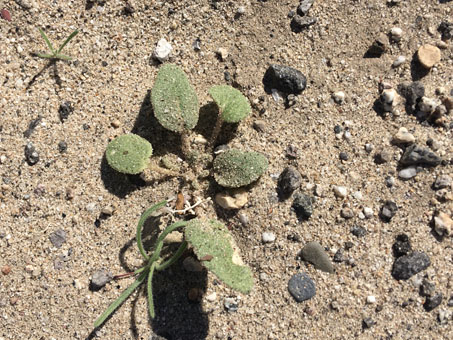THE UC HIVE MAR 2022
The San Felipe Desert Revisited
Many desert plant species, and even some animals, are ephemeral, while others are steady and somewhat predictable, and some just shut down and tough out the heat and lack of water. This boom or bust cycle common in the desert makes studying the plants challenging because you don't know when they might next appear.
It can be years between rains, so a landscape you think you know today is very likely to surprise you tomorrow. What looks parched and dead or dying can spring to life in just a few days with a little moisture or even just with a slight warming of the days. And what pops up today may not necessarily return with the next rains.
I’ve come to appreciate taking the long view when it comes to my plant studies as I’ve observed, documented and read about the flora on the Baja California Peninsula over the last two decades, and I know there is still so much more to learn and discover. Each time we travel up and down the peninsula, something we’ve done about every six months for the past 27 years, I’m almost always rewarded with one or two plants I’ve never seen before, or am surprised by an old friend that has finally revealed the secrets of its leaves, flowers or fruit.
For the last couple of years, we’ve been taking a different route to and from Mulegé, on Hwy 5 from Laguna Chapala to Mexicali via the Gulf of California and the San Felipe Desert.
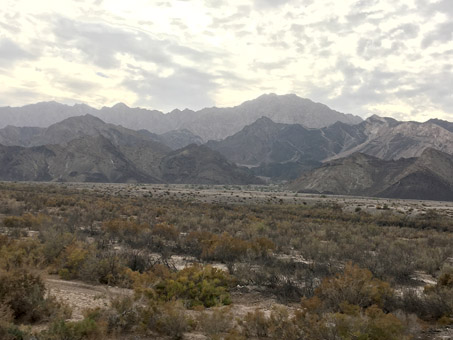
Transpeninsular range & alkali flats west of highway near Cucupá, BC.

Dunes with Cresotebush (Larrea tridentata, Zygophyllaceae) just south of Laguna Salada near La Ventana, BC.
If you’ve followed my previous posts (Apr 2020, Sep 2020, Apr 2021, Jul 2021 and Aug 2021), you’ll know it’s a stark region backed by the rugged, volcanic Transpeninsular ranges. A moonscape, or better yet, a Mars-scape, could describe many parts of it: bare, jagged rocks jutting out of the desert floor, itself featureless and seemingly barren in places.
But stop the car, walk away from the highway even a few feet, and take a really close look, and you may be lucky to see a surprising amount of plant life. It may not be green, or apparently alive at that precise moment, but it’s there in the cracks of the pavement or the gravel at the side of the road, in a dip between sand dunes, or in the shadow of a large rock, evidence that life exists and may show itself again sometime when the conditions are just right.
I've enjoyed getting to know the region little by little with each trip. Familiarity grows and recognition sharpens with each new species I encounter, while at almost every bend in the road, I continue to be awed by the sheer magnitude of the landscape and filled with great respect for life's persistent nature. I look forward to nurturing this newfound relationship over the coming years.
This stop at the side of the road is near the base of some jagged mountains with a wind and water swept surface. When I think of barren desert, this is a great example. Click on the title above to see what I mean. The few plants below were growing at the side of the highway on piles of debris from road work. I had a tough time getting photos of the flowers as the wind was blasting.

From a distance, it looks like half of the plant is dried up. But it is really a pistillate plant (L) and staminate plant (R) of Desert Holly (Atriplex hymenelytra, Chenopodiaceae) which is a dioecious species. See below for details of what you´re seeing.

Desert Holly leaves (Atriplex hymenelytra, Chenopodiaceae). The leathery leaves are silvery green, sometimes tinged purple. A dense layer of scales reflect light and heat, helping with water retention.
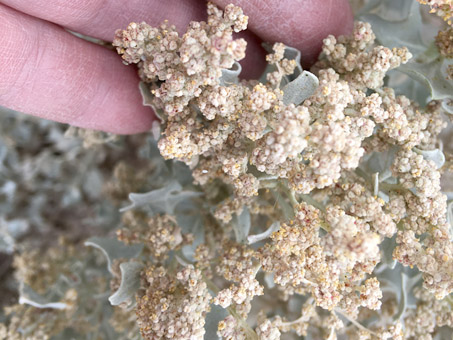
Staminate flowers of Desert Holly (Atriplex hymenelytra, Chenopodiaceae).
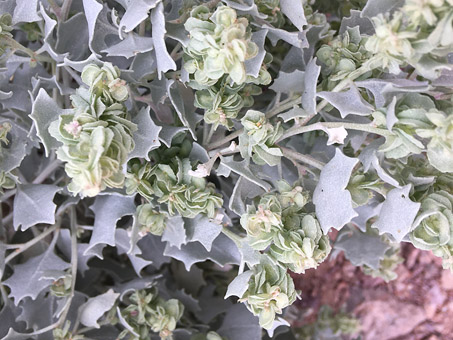
Bracts (pistillate flowers) of Desert Holly (Atriplex hymenelytra, Chenopodiaceae).
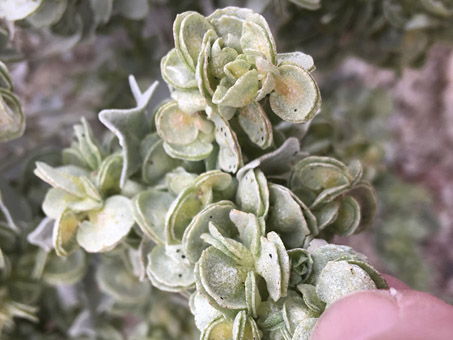
Bracts (pistillate flowers) of Desert Holly (Atriplex hymenelytra, Chenopodiaceae).

Heartleaf Suncup (Chylismia cardiophylla subsp. cardiophylla). The entire plant is about 10 cm H. Flowers c. 1 cm D.
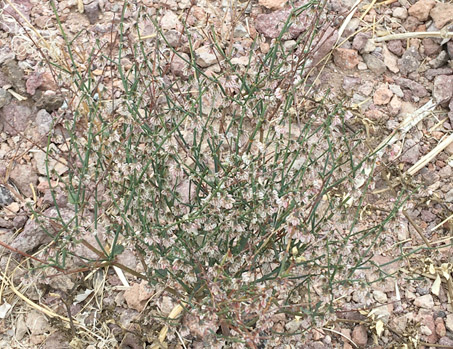
Skeletonweed (Eriogonum deflexum var. deflexum, Polygonaceae). These small plants, when seen from a distance in profile, look like miniature trees along the side of the road with a stem that resembles a trunk and the full, round branches above.
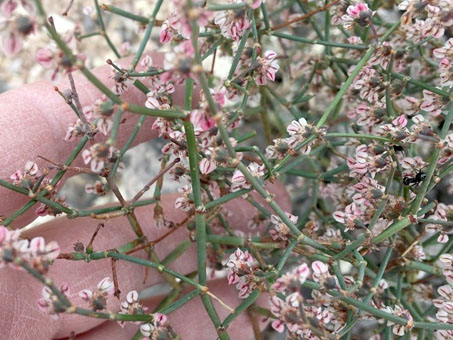
Flowers of Skeletonweed are minute, about 3-5 mm D and appear to dangle from the branches. Leaves are basal, green above, white below.
Hwy 5 – Km 19-20 S of San Felipe
We stopped here briefly because the desert dunes all around were dusted with a pale green and I wanted to see what was starting to sprout. There were many different species, some familiar, others not. It looks like there would be flowers carpeting the area in short time, but sadly we wouldn't be the ones to enjoy them.
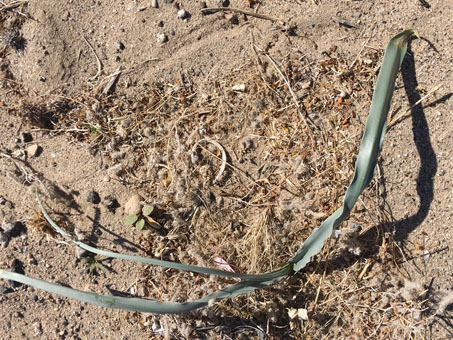
In the trench along the side of the road, I came across the young leaves of Desert Lily / Ajo Silvestre (Hesperocallis undulata, Agavaceae), a native species that grows from a deeply buried bulb.
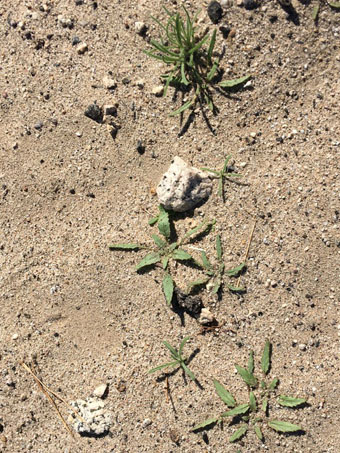
These look like sprouts of Clavate fruited primrose (Chylismia claviformis, Onagraceae). There are also four uncommon or rare endemic subspecies throughout the San Felipe Desert. Each plant is c. 6-7 cm D here.
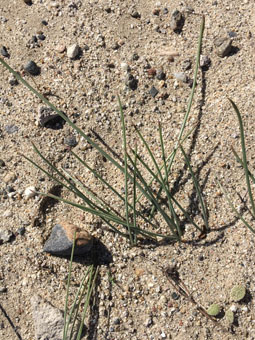
Not much information on this tiny plant. The stems (or leaves?) were terete, glabrous, slightly fleshy and 5-6 cm L x 2 mm D at this point. Whatever it is, there was a large number of them visible in the area.
Hwy 5 - Km 87-90 S of San Felipe, near El Huerfanito
We pulled off for a break and to check on a species I've seen before near the side of the road. The area is near the top of a grade, facing southeast and fully exposed to the sun and wind. Very little grows here. But there are a few tough plants.
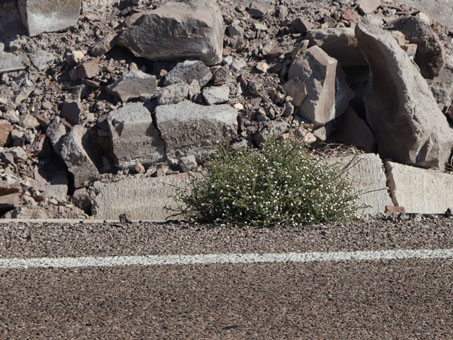
A medium-sized Cryptantha (possibly Common Cryptantha, C. intermedia) at roadside. It was about 40 cm H x 60 cm D, and healthy as could be.
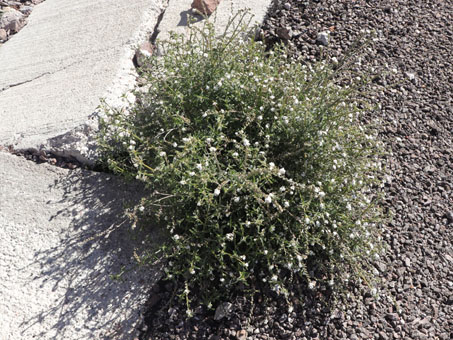
The Cryptantha, as I soon discovered, was actually growing right out of the crack between the pavement and the cement curbing. How it had grown this large without being flattened by passing trucks is a miracle.
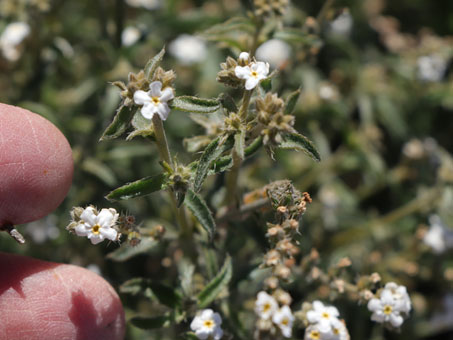
Flowers of the Cryptantha. The inflorescences stood erect, with just a little bit of helically coiled buds visible at the tips. Each flower was c. 4-6 mm D.
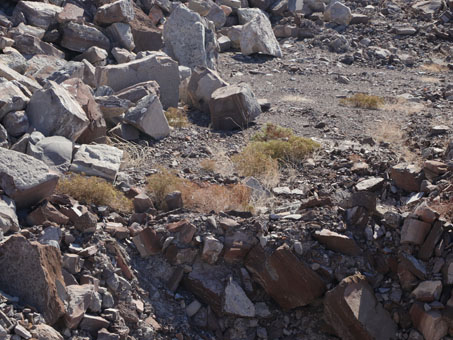
Lots of plants of San Felipe Buckwheat (Eriogonum galioides, Polygonaceae) nearby. The plants are low (about 15-25 cm H) and quite inconspicuous, especially while driving.
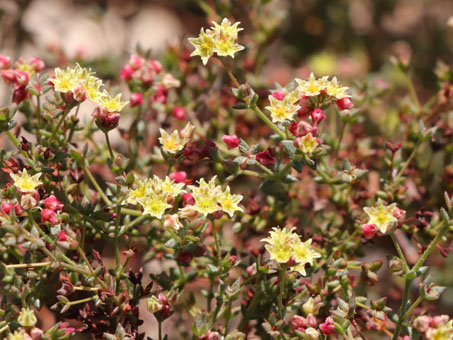
San Felipe Buckwheat (Eriogonum galioides) is a Baja California restricted endemic. Many of the plants were covered in tiny flowers.
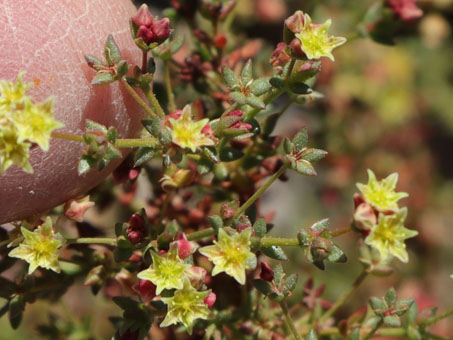
The flowers of San Felipe Buckwheat measure about 4-5 mm D. The buds are red and the flower turns rusty as it dries.
We've reached the end of this month's entry. It's currently very dry in Mulegé with little evidence of the big rain I am told fell in early January. Hopefully there will be some more plants of interest to share with you all next month. Until next time, hasta pronto...
Debra Valov—Curatorial Volunteer
References and Resources
Atriplex hymenelytra. Flora of North America (FNA) Vol. 4 Page 330, 369, 371, 376. (16 February 2022).
http://www.efloras.org/florataxon.aspx?flora_id=1&taxon_id=242415594
Rebman, J. P., J. Gibson, and K. Rich, 2016. Annotated checklist of the vascular plants of Baja California, Mexico. Proceedings of the San Diego Society of Natural History, No. 45, 15 November 2016. San Diego Natural History Museum, San Diego, CA. Full text available online.
Rebman, J. P and Roberts, N. C. (2012). Baja California Plant Field Guide. San Diego, CA: Sunbelt Publications. Descriptions and distribution.
Valov, D. (2020). An Annotated Checklist of the Vascular Plants of Mulegé, Baja California, Mexico. Madroño 67(3), 115-160, (23 December 2020). https://doi.org/10.3120/0024-9637-67.3.115
Wiggins, I. L. (1980). The Flora of Baja California. Stanford University Press. Keys and descriptions.












